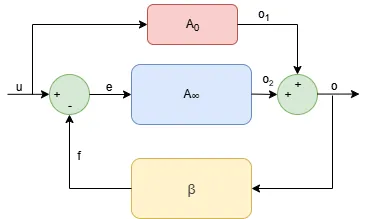General Feedback Theorem
About Middlebrook's General Feedback Theorem: introduction, derivation and importance in real world feedback systems
Why GFT

Middlebrook’s General Feedback Theory (GFT) is a powerful tool because it highlights the significance of direct coupling between input and output in feedback systems. This direct path (very often overlooked in traditional loop analysis) can dominate system behavior, particularly in high-performance analog circuits. GFT allows engineers to isolate and quantify this coupling, revealing how it shapes gain, bandwidth, and stability. By focusing on signal flow rather than just topology, GFT delivers low-entropy, design-relevant insights that make it easier to optimize circuits with precision and clarity.
GFT formula
The Middlebrook's General Feedback Theorem formula is $$G(s) = \frac{u_o}{u_i} = G_{\infty}\frac{T}{1+T} + G_0\frac{1}{1+T}$$ where $$T(s) = \frac{u_y}{u_x} \rvert_{u_i=0} \qquad T_n(s) = \frac{u_y}{u_x} \rvert_{u_0\rightarrow 0}$$ $$G_{\infty}(s) = \frac{u_o}{u_i} \rvert_{u_y\rightarrow 0} \qquad G_{0}(s) = \frac{u_o}{u_i} \rvert_{u_x\rightarrow 0}$$ and here is the reprocity relationship $$\frac{T_n(s)}{T(s)} = \frac{G_{\infty}(s)}{G_0(s)}$$
Comments
Be polite and respectful in the comments section. In case of doubts, read this before posting.
Posted comments ⮧
Comment section still empty.
INDEX
INFO
STATISTICS
CONTACTS
SHARE






